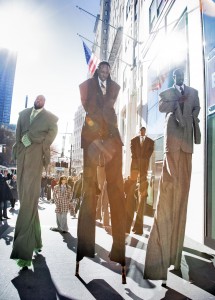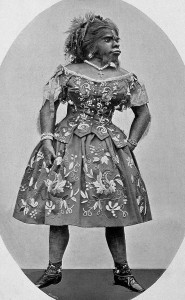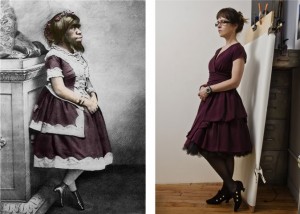This is the sixth post in a series of posts focused on the course on beauty that I am coordinating/teaching for business students at UW-Madison. In the fourth week of the Beauty Class I wanted to explore the notion, articulated by Jeanette Winterson, that “art can waken us to truths about ourselves and the world.†The class examined works by two artists: monologist/raconteur Mike Daisey, whose piece The Agony and Ecstasy of Steve Jobs was aimed at getting people to think about about the injurious labor conditions by which their beautiful Apple devices are made; and transdisciplinary social artist Laura Anderson Barbata (born in Mexico and currently based in New York City), whose ongoing Julia Pastrana Project has been aimed at getting people to see the “ugliest woman in the world†as a human being with rights rather than as an object of scientific study or historical artifact.
On the Nature of Artistic Truth: Mike Daisey & His This American Life Fiasco
As probably anyone reading this blog knows, in 2010 Mike Daisey, a renowned storyteller, created a show that centered on his experience of going to China and witnessing firsthand the egregious working conditions in the FoxConn factory in Shenzhen where Apple products are made. When it premiered, and as it gained attention, the piece was hailed by many theater critics and business journalists as an exceedingly well-researched and well-crafted piece that succeeded in humanizing the issues, arousing empathy, and sustaining public discussion around unfair labor practices by overseas manufacturers of Apple products and other electronic devices.
Portfolio Assignment
The first part of the weekly portfolio assignment was for students to listen to Mr. Daisey and the Apple Factory, an episode of This American Life in which Daisey performs a version of his show. After listening to the episode they were asked to write down their thoughts and feelings about Apple, its products, Mike Daisey, and theater/storytelling.
Unsurprisingly, almost all the students in my class own one or more apple products; somewhat surprisingly, more than a few have actually worked for Apple. While a couple of students were skeptical of Daisey’s piece, and wondered how true it was as they were listening to it, most were completely absorbed by the story and deeply troubled by it. Here are a handful of pretty typical responses:
#1 – After listening to this podcast, I am questioning how many of my technology products are made and the path each item takes before it gets into my hands.
#2 – It makes me feel ashamed that companies would allow sweatshops and abusive labor situations to occur. The stories about the suicides and injuries make me feel sick …
#3 – This has definitely changed my perception of Apple. They are such a well-known company and treat their employees very well, but as soon as the jobs go overseas to increase their margins, then everything goes down the gutter. Apple, being a front-runner in future technology should also be a front-runner in global-labor rights. This was definitely a good podcast to listen to.
#4 Throughout this story I thought about this winter break and how I was annoyed when I ordered my new iPhone that the ship date was TBD … Reflecting on this experience, it didn’t even cross my mind that there are workers making these phones. Daisey talked about how when there’s a new Apple product it’s not uncommon for workers to work 18 hour days. It made me feel guilty for being annoyed that there was a wait for my new iPhone. I realized it’s people like me … that cause [Apple’s] manufacturers in China to feel pressure to work their employees overtime to meet demands like mine.
#5  … Immediately after [listening to] the audio, I felt upset. … My relationship with my device changed—I stared at it differently.
I then asked the students to listen to a second This American Life episode featuring Daisey—the Retraction episode, in which Daisey is interrogated about certain facts of his story that do not seem to hold up under rigorous fact-checking. Over the course of the episode Daisey and his story come undone as he acknowledges, in what seems to be a state of distress, that he fabricated some of the events portrayed as truths (i.e., facts) in his story.
Once again, I asked the students to write down their thoughts and feelings after listening to the podcast. I also asked them to reflect on the nature of artistic truth and whether and how it differs from other types of truth (for instance, in journalism).
Unsurprisingly, almost all the students initially were “outraged” to realize that some of the most moving and troubling parts of Daisey’s story were not true—meaning he had not actually experienced some of the events that he claimed to have experienced. Many used the word “betrayed†to describe how they felt; some indicated that they felt foolish or duped or silly for having become emotionally involved in the first episode.
A handful of students were ready to write-off Daisey’s story in its entirety because of its fabricated parts—for them, the piece had lost all integrity. However, a majority of students were able to see both sides. In their written refelections many were able to see the larger truth Daisey was trying to convey and acknowledge the artistic and social value of his theater piece, even while feeling that the choice to present the work as fact within a journalistic frame was short-sighted, inappropriate, unethical, or deceitful.
Here is one student’s written response to the Retraction episode. It is an example of how many students reconciled these two sides.
… I believe it was wrong for him to lie on This American Life. It was not wrong to create this story and theater piece of work; but speaking on this show and implying that his story was journalism was completely wrong. Artistic truth and journalistic truth are completely different … Daisey’s piece is artistic. His story is moving and makes people think about the working conditions overseas, but it is not all factual.
Although my views have changed and I am disappointed that Daisey thought it was perfectly fine to lie on national [public] radio, the fact that these working conditions could still exist is unacceptable. Charles Duhigg states at the very end of the podcast that we, as in the people who are users of Apple products (such as myself), are not only the direct beneficiaries of these conditions, but the reason they exist. …Our nation is not demanding different conditions …
A couple of students tweeted their thoughts after listening to the second episode and in both cases Daisey responded to them—in one instance sending a link to a blog post on the topic. We spent some time discussing sections from that post and considering Daisey’s “rules” and how, in principle, he reconciles telling a good story with getting the facts right.
Laura Anderson Barbata: Visiting Guest Artist
For the second half of class the students watched a presentation by UW-Madison Artist in Residence, Laura Anderson Barbata, who creates transdisciplinary public art performances that speak to social issues. Before giving her own presentation, Barbata was able to join us for the discussion of Daisey’s work. She has seen all of Daisey’s monologues and sees tremendous craft and value in his work (as do I). After soliciting comments from the students, I asked Barbata if her high regard for Daisey and his work as an artist was diminished in light of the scandal surrounding This American Life. She responded, “Not at all.”
Barbata’s lecture centered on her Julia Pastrana Project, which came about as a result of participating in a 2003 theater piece created by her sister in which audience members sat in total darkness for hours listening to the story of Julia Pastrana (1834-1860)—the “ugliest woman in the world.†Julia was a highly intelligent woman who suffered from a condition that caused excessive hair growth on her face and body. She spent most of her adult life as a carnival attraction being advertised as a hybrid bear-woman. After her death, during childbirth, the bodies of Julia and her baby were preserved, studied by scientists, and toured as freak-show curiosities. In response to public outrage they were taken off the touring circuit in the 1970s (!) and stored in a closet at a university in Norway, where they began to decay due to exposure to water, sunlight, and rodents.  When this decay was discovered the remains were sealed in a coffin and stored in the Department of Anatomy at the Oslo Forensic Institute.
And this is where the story ended when Barbata’s sister made her theater piece and submitted a petition, signed by hundreds, requesting that the remains be repatriated and properly buried. There was no response to the request; and this compelled Laura Anderson Barbata to use an artist fellowship grant to travel to Norway in 2004 to better understand Julia Pastrana and what had happened to the petition.
This initial  inquiry became a multi-year project, the aim of which was to get people to see Julia not as an artifact but as a human, a woman with a medical condition, a mother, and a Catholic, with rights—rights to be repatriated to her native home in Mexico, have her death authenticated and acknowledged, receive last rights, and be granted a proper burial. The project was a success. Pastrana was returned to her small village in Mexico and buried in 2013. You can read an excellent chronology of Pastrana’s life and Barbata’s project, here. One of the artworks associated with the project is the print Julia y Laura (below) which features the only known photo of Julia Pastrana when she was alive and the artist, Laura Anderson Barbata.
***
In reflecting on these works by Mike Daisey and Laura Anderson Barbata I am reminded of Elaine Scarry’s argument that, etymologically, the word that best represents the opposite of beauty is injury, not ugliness. I wanted them to think about how and why these artists were able to awaken consciousness to injuries being perpetuated when the facts of these stories (which were known for years before these artists made their work) had failed to do so. I wanted them to see how these artists help us see parts in relationship to the whole (person or system)–and in particular, our part in perpetuating injuries.
However, I also wanted them to experience how easy it is to forget the initial empathy we feel for the workers at FoxConn and order the new Iphone anyway; how easy it is to sign a petition and then promptly forget about Julia Pastrana stuck in a coffin in a lab in Oslo.This suggests that we need a process for remembering, for keeping our eyes open, for being awakened to truths about ourselves and our world over and over again.
As Jeanette Winterson says, “Art can bring us back to consciousness, sometimes quietly, sometimes dramatically, but the responsibility to act on what we find is ours.”
Post Script:
While in class, Laura Anderson Barbata also took a few moments to show a video of her work Intervention Wall Street, a street performance that featured African American men (the Brooklyn Jumbies) walking on stilts in suits through Wall Street during the Occupy Movement, handing out gold chocolate coins to actual Wall Street suits, while the O’Jays song For the Love of Money played in the background. Her aim was to engage and respond to the social and economic issues raised by the economic collapse of Wall Street. You can watch the trailer below to get a sense of the piece (Laura Anderson Barbata is the woman featured in the piece.) Coincidentally, the original video artwork Intervention Wall Street is owned by the school of management at my university in the Netherlands, where it is a catalyst for discussions.



